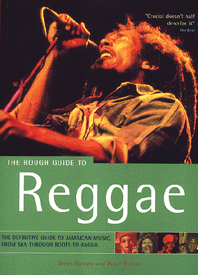
It hardly seems possible that the first edition of this book
was published in 1997. But four years have in fact passed by and
the long awaited second edition of The Rough Guide To Reggae is
now out. Much has changed in the world of reggae in those four
years, many new names have burst upon the scene, and many other
books have been written about the music. From being a relative
pioneer in its first edition, the Rough Guide To Reggae in its
second edition now takes its place in a far more crowded field
and as something of an elder statesman.
So how have Steve Barrow and Peter Dalton reacted to these changing events? The substance of their book is unchanged, arranged chronologically in self contained chapters such as 'The beginnings: mento to ska", "Rude boys and rocksteady, "Ragga" and so on. The second edition now benefits from a contents page at the front, making it easier still to navigate around. This is essential in a book of 475 closely written pages, 80 pages longer than the first edition. Each chapter features a wealth of appropriate record listening, all available on easy to find CD albums. The interviews, the wealth of meticulous detail, the visual material like photos, flyers, record sleeves and labels are still there. The book is clear and accessible for those new to the music and with sufficient material to keep the most knowledgeable reggae fan coming back for more.
A refreshing feature of the book is the readiness of the writers to be honest when demanded, as in observing that Keith Hudson "possessed a pretty dismal voice himself but clearly knew how to get the best out of others in the studio." Or commenting that one recommended CD is spoilt by "the poor quality restoration of some cuts" and that on some tracks "muffled clicks and pops spoil the tunes completely." So when they do make a recommendation, their judgements can always be relied upon.
The bulk of the book, which covers the development of Jamaican music from its origins to its eighties dancehall phase, has not greatly changed. One very welcome addition to the first chapter is a new section entitled Jamaican jazz- a brief survey, which is actually a detailed and fascinating survey of a hitherto neglected area of Jamaican music, covering jazz on the island from the early big bands to current innovators, taking in the careers of such men as Monty Alexander, Ernest Ranglin and Courtney Pine along the way. Otherwise, the main additions are reviews of CDs of previously unreleased material that have come onto the market over the last few years.
Inevitably the main differences are to be found towards the end of the book in its coverage of current reggae. The Ragga chapter notes the advent of hip hop influenced dancehall 'crews' like Ward 21 and Innocent Crew and features a new generation of artists such as Vegas, Lexxus, Red Rat and Elephant Man who have emerged since the first edition was written. In the first edition, such contemporary cultural artists as Yami Bolo, Garnett Silk and Luciano were featured within the Ragga chapter in a short section entitled Rasta in the dancehall. The second edition further underlines the importance of such artists with a new and distinct chapter entitled Rasta renaissance. This in turn boasts an entire section on the Bobo Ashanti branch of the Rastafarian movement and the careers of such highly influential adherents as Capleton, Sizzla and Anthony B. The chapter on Reggae in the USA has also been expanded with a particularly interesting consideration of the interaction between ragga and hip hop in the US.
Reggae's recent publishing boom is reflected in an expanded books section although, disappointingly, the even greater proliferation of reggae websites seems to have passed by the second edition, with only two sites featured here. More has been written about Jamaican music in the last four years than in the whole preceding forty years or so of its independent existence. Having sold more than than 25,000 copies of its first edition The Rough Guide To Reggae can surely take some credit for making that possible. In the midst of all this, Steve Barrow and Peter Dalton's book remains the definitive work of reference and there seems no reason why The Rough Guide To Reggae should not become a permanent resource, continuing to update itself every few years.